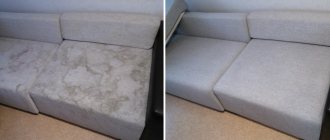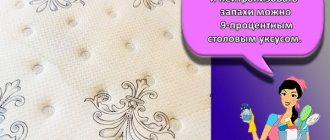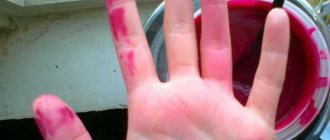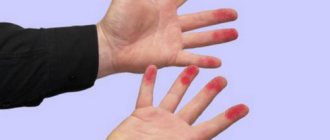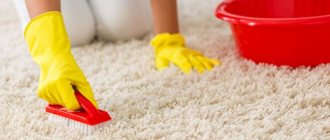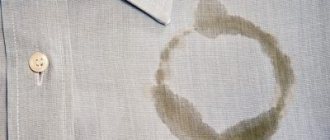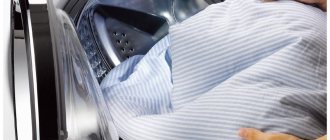White spots from alcohol
Liquids containing alcohol leave white spots due to the chemical activity of the solution. Alcohol molecules react with the molecules of the varnish finish, destroying it, and the transparency of the varnish is impaired. Minor damage to modern varnish can be eliminated by polishing. To do this, use a thin abrasive paste to remove the damage until the polish remains intact. The varnish will become thinner, but there will be no stain.
Preventive measures: cover the tabletop of expensive furniture with organic glass cut to shape.
Stains from iron, hot and direct sunlight
White spots are left behind by cups of hot drinks. Very ugly marks in the shape of crescents and circles are a result of exposure to hot cans, glasses, bottles.
When heated, the polymer, which is any modern varnish, changes its density, therefore, the physical properties change, namely transparency. This happens throughout the entire finishing depth. Elimination - complete replacement in a restoration workshop by a professional restorer using special equipment.
Wooden surfaces
Wood surfaces should be cleaned carefully, without using aggressive agents or hard brushes, so as not to leave damage to the surface.
| Stain type | Means | Cleaning method |
| Traces of fat | Drying oil | A simple method to remove grease stains from kitchen wood furniture. A cotton pad is moistened with drying oil and applied to the stain. Rub with gentle movements. Remove residue with a damp microfiber cloth |
| Oil | Ammonia and lemon juice | 2 teaspoons of juice and a teaspoon of ammonia are dissolved in a liter of water. Wet the sponge with the resulting liquid and wipe the stain. Do not wash off, wipe dry with a piece of soft cloth. If contamination remains, repeat the procedure. |
| Fat | Talc | Powder is poured onto the stained area, left for a few minutes, then wiped with a clean damp cloth. |
| Grease stains on solid walnut or oak | Iodine or dark beer | Apply a small amount of liquid to a cotton pad and treat the stain. Moisten a soft cloth with water and wipe the surface |
| Water marks | Salt and vegetable oil | Salt is poured onto the problem area so that it completely covers the mark. Oil is poured on top. Leave for 2 hours. Clean off any remaining mixture, wipe with a damp cloth and then with microfiber. Cover with wax and polish. You can use flour instead of salt |
| Water stains | Burdock, flaxseed, vaseline, olive or sunflower oil | This method is used for vertical surfaces (cabinet doors, side walls). A microfiber cloth or piece of soft cloth is moistened with vegetable oil and the stain is intensively rubbed. Collect residues with a clean damp cloth |
| Water marks | Cigarette ash | Ashes are applied to the stain and filled with vegetable oil. Use a piece of wool to polish the problem area |
| Coffee | Ammonia and glycerin | Combine glycerin and ammonia in equal proportions, apply to the stain, and leave for 25-30 minutes. Then wipe with a damp sponge |
| Ink | Soda | Prepare a weak soda solution, moisten a cotton pad with it, and apply it to the ink marks. Leave for a while, then carefully remove the remaining product with a damp cloth and wipe dry. |
| Darkening | Vegetable oil and red wine | The liquids are combined in equal proportions and the tarnished areas are wiped. You can replace wine with glycerin |
| Traces of fire | Mayonnaise | The method is suitable for minor damage. The sauce is applied to the burnt area and left for 30 minutes. Then wipe with a soft cloth, removing any remaining mayonnaise. |
| Traces of fire | Sandpaper | Blackened areas are cleaned with fine-grained sandpaper and the surface is coated with varnish. |
| Black spots of various origins | Edible salt and burdock oil | Oil and salt are mixed in such proportions to form a paste. Apply to blackened areas. You need to leave the mixture for several hours: the oil will soften the wood, and the salt will absorb dirt. Then the remaining mass is collected with a damp cloth, wiped with a sponge soaked in soapy water, wiped dry and polished |
| Wax | Hairdryer | Turning the device on to hot air mode, bring it to the frozen wax. Wait until it softens, then remove with a damp cloth. The treated surface is polished |
We suggest you read How to get rid of centipedes in a living room with your own hands
Use vinegar
Wood that is not treated and does not have a special coating is quite capricious. If stains are found on furniture made from such wood, then there is no need to worry. You can use a familiar and inexpensive product that most people have in their kitchen.
For the procedure, you should mix one tablespoon of vinegar and two tablespoons of table salt. You should get a thick paste. Next, you need to wipe the stain with this mixture, but not too zealously. The remaining mixture is removed with a damp cloth. The wood is then polished as usual to restore its original shine.
A Brazilian travels 36 km by bike every day to take his loved one home.
Rare shot: Viktoria Isakova showed her grown-up daughter from Yuri Moroz (new photo)
It’s good to wash often: myths about shampoo and hair care that only harm
Chipboard or MDF
To remove fresh stains from furniture made from chipboard or MDF, a simple damp cloth is enough. But if the contamination is old, more effective means will be required.
| Stain type | Means | Cleaning method |
| Fat | Baby soap | Rub the stained area with a soft sponge dipped in soapy water. Blot remaining liquid with a paper towel |
| Juice, chocolate, wine | Dishwashing liquid | A small amount of gel is applied to a sponge, applied to the stain, and left for a few minutes. Afterwards, carefully wipe off the stain, wash off the remaining foam with a damp cloth and wipe dry with a napkin. |
| Coffee | Ammonia or ethyl alcohol | Moisten a cotton pad with the liquid and treat the dark spot. Wipe dry with a paper towel or soft cloth |
| Acid marks | Citric acid, vinegar | Apply a weak solution of one of the liquids to the stain, leave for a few minutes, and remove with a damp cloth. Wipe with a microfiber cloth |
| Chewing gum or wax | Ice | Apply an ice cube to the stain and wait until it hardens. Scrape off with a plastic scraper |
| A drop of nail polish, a mark of lipstick, a streak of felt-tip pen | Acetone or other solvent | Apply a small amount of solvent to a cotton pad and work the stain with gentle movements. Wipe first with a damp cloth, then with a paper towel |
If none of the tried remedies help, it is worth masking the contamination. To do this, use special pencils for laminate flooring, which can be purchased at hardware or furniture stores. A composition that is as close as possible to the color of the MDF or chipboard surface is applied to the darkened area and polished.
How to remove an iodine stain from a table?
If iodine spills on a wooden table while treating a wound, hydrogen peroxide will help remove it. To do this, you need to clean the area with a swab soaked in peroxide, and then wipe with clean water.
Another effective remedy is lemon, from which you need to squeeze the juice. Leave a cotton swab soaked in lemon juice for 5 minutes. You can also combine hydrogen peroxide and lemon, which will only enhance the whitening effect.
A light or dark stain on a wooden table will not become a cause for upset if you begin measures to remove it in time.
For best results, the cause of the unpleasant mark should be taken into account. Back to all news
How to remove stains on wooden surfaces
Special scrupulousness and care are required when washing wood so as not to leave defects and scratches. It is not recommended to use aggressive detergents or rough brushes.
Tips for removing stains from wood:
- To clean products made from natural oak, you will need an iodine solution, a cotton pad, and a rag. Iodine is applied to the stained surface with a cotton pad, then blotted with a rag and wiped dry.
- To remove light stains from a wooden door, use a few drops of olive oil and a piece of cloth. You need to drop 2-3 ml of oil onto the fabric. The coating is wiped first with a cloth soaked in oil, and then with a dry microfiber cloth.
- Ammonia and lemon juice will help get rid of stains on a wooden surface. You need to pour 0.5 water into a large bowl. Pour in 0.5 teaspoon of ammonia and 1 teaspoon of lemon juice. Mix the liquid thoroughly and wipe the dirty area on the wooden surface with it.
We suggest you read: How to clean brass from oxides - About metal
Cleans wood and heated beer. After cleaning, it is advisable to polish the furniture or door with wax.
White spots on modern expensive furniture
The diagnosis is as follows: the varnish has turned white. Lost transparency. As org. glass after exposure to a chemical or abrasive. This could happen for several reasons.
1. Aggressive polish. It is possible that when the door was treated with a polish containing an abrasive or solvent, a matte stain appeared. To remove it, the processing was continued and thus rendered the entire surface of the part unusable. This is a common type of damage after the services of hired maids.
2. Poor quality (inappropriate) finishing material.
3. Violation of technology when finishing the door.
Eliminate the defect.
1. Remove the white varnish that has become opaque until the wood is clean.
2. Tint the wooden surface to match the overall tone of the chest of drawers.
3. Coat by hand, adjusting the layer thickness and gloss level of the varnish to the existing finish.
By sending us a completed form with photographs, as well as asking a question, you will receive complete information about the item (what it is, wood material, age of the furniture) and the cost of restoration work. Next, the restorer will come to the location of the furniture, inspect it and determine the final price of the restoration. The price will not change during the restoration process. Departure is free.
Useful articles: Furniture care
We will be glad to see you in our workshop.
Sincerely, Elena Zhilina.
Estimated cost of restoration
| Price, thousand rubles | |
| Chair | 5 — 20 |
| Armchair | 10 — 30 |
| Sofa | 30 — 60 |
| Table | 10 — 40 |
| Buffet | 30 — 80 |
| Closet | 30 — 80 |
Restoration of paintwork
| Finishing | RUB/sq. meter |
| Waxing | 500 |
| Polishing | 1500 |
| Shellac | 2000 |
| Gilding | 3000 |
Restoration of decorative coating
| Finishing | RUB/sq. dm |
| Patination | 50 |
| painting | 200 |
| Marquetry | 500 |
| Mosaic | 1000 |
By sending us a completed form with photographs, as well as asking a question, you will receive complete information about the item (what it is, material, age) and the cost of restoration work. Next, the restorer will come to the site, inspect it, and determine the final price of the restoration.
The final price will not change. Departure is free.
How to remove stains from upholstered furniture
Soft sofas and armchairs are loved by children and pets. After them, various kinds of stains often remain on the upholstery.
The following methods will help you get rid of this problem:
- Salt. A pinch of fine salt is carefully rubbed into the problem area with a sponge. Periodically change the fatty salt to clean salt. Then the stained area is blotted with a napkin soaked in diluted alcohol.
- Laundry soap. The napkin is applied to the problem area 5-6 times so that it absorbs the fat. The soap is crushed with a grater, then dissolved in heated water and whipped until foamy. A cloth or sponge is soaked in the liquid. The dirty area is thoroughly wiped with a sponge, and then treated with a damp cloth.
- Vinegar. To eliminate the unpleasant odor, wipe off the dirt with a small amount of ordinary table vinegar mixed with cold water.
- Baking soda. After removing the stain, its remains are treated with soda. Pour 2 tablespoons onto the stain and wait 2-3 hours. The substance will absorb any remaining dirt.
Special detergents can be used to wash upholstered furniture. Before use, be sure to read the instructions on the package. The cleaning scheme is approximately the same: liquid or foam is applied to the problem area, wait a few minutes. Fat along with foam is removed with brushes, special sponges or a vacuum cleaner.
3 products that will help you quickly remove greasy stains on furniture
There are 3 universal products that quickly remove grease stains from furniture:
- Mustard powder. It copes well with washing any furniture coverings, dissolving plaque. The powder is mixed with water and applied to the contaminated areas, after which the area is wiped with a dry cloth.
- A mixture of clay and vinegar. Suitable for cleaning not only wood, but also tiles. The clay is dissolved with a small amount of vinegar and the surface is treated with the resulting mixture. After removing stains, wipe the area with a sponge soaked in clean water.
- Olive oil and soda. The substances are mixed in a 2:1 ratio, after which they are applied with a soft brush to the problem area. Wait 20-30 minutes and remove the fat with a rag.
How to remove stains from polished furniture
Polished tables have a beautiful appearance, but even the smallest stains and defects are too noticeable on their surface.
You can get rid of greasy blots on a shiny coating in the following ways:
- Apply talc or powder. Sprinkle the product over the stained surface and leave for several minutes. Then wipe the area with a microfiber cloth. The consequences of contamination are wiped off first with a cloth dampened in water, and then with a dry cloth.
- Wax stains can be removed with a sharp object. The knife is heated in boiled water. Using the blunt side of a knife blade, carefully remove pieces of wax from the coating to avoid scratches. After removing the wax, wipe off the stain with a cloth moistened with gasoline.
- 250-300 ml of beer is poured into the container and a small piece of wax is placed. The solution is boiled for 3 minutes, then infused until warm. The mixture is spread on the problem area of the surface, wiped with a sponge or cloth.
The described cleaning methods lead to noticeable results if the sequence of actions is fully followed.
Where do stains come from?
Wooden furniture is certainly beautiful, but rather capricious. One of the household members forgot to use a special stand for a mug of tea and spilled some directly on the table. In this case, a stain will definitely remain. If it is removed immediately, there should be no consequences for the furniture. However, if you forget and do it untimely, the stain threatens the aesthetic appearance of the table. What to do?
Leather
Removing stains from leather furniture is not a very difficult process. The main thing is to use only soft sponges and products without abrasive particles, so as not to damage the material.
We suggest you familiarize yourself with How to properly wash jeans by hand: can they be washed with other things?
Fresh stains can be easily removed with a damp cloth. If the contamination has already dried, you can use one of the following methods:
- Ammonia and glycerin. This mixture will remove dark ink stains on light skin. It cannot be used on colored or black surfaces - a noticeable whitish mark will remain. Ammonia in pure form or with the addition of a small amount of glycerin is applied to the blackened area and left for several minutes. Then remove the residue with a damp sponge.
- Milk. Suitable for white leather upholstery. Wipe the problem area with a cotton pad soaked in milk. This method can be used not only to remove stains, but also to refresh the color of the material.
- Ammonia or weak vinegar solution (for light skin). Moisten a soft cloth with one of the liquids and wipe off the greasy stain. Afterwards, treat the cleaned area with vegetable oil (castor, sunflower, linseed) and polish with microfiber or suede. This is necessary to protect the material from cracks.
- Talc or starch. Used to remove traces of oil from skin of any color. Sprinkle the stain generously with powder and leave for several hours. When the talc absorbs the dirt, it is cleaned with a soft cloth. Wipe the leather upholstery first with soapy water and then with a clean damp cloth.
- Soap solution. Effective against darkened blood stains. Gently treat the stain with a damp soapy sponge and then wipe with a dry cloth.
Dry with a hairdryer
Another universal and safe method. Surely there is a hairdryer in every woman’s home. It is an excellent tool not only for drying hair, but also for removing water stains on wooden furniture.
So what needs to be done. First of all, it is better to use a special narrow nozzle to specifically direct the air flow to the problem area and avoid the impact of the hot flow on everyone else. It is necessary to constantly move the hairdryer to ensure even drying. The stain should disappear after a few seconds of heating.
Water stains
Several improvised means come to help.
- You can take mayonnaise, apply it to the stain and leave it to dry overnight, then wipe it off with felt in the morning. Try the method on the side of the stain first to see if a greasy mark remains after scrubbing with mayonnaise.
- Dry with a hairdryer. The temperature on the item to be dried should be medium and should be dried until completely dry. The final step: wipe the area with a soft cloth and apply something that will prevent the wood from drying out. For example, oil.
- You can experiment with flour or cigarette ash. We leave them on the contamination, at this time we prepare a mixture to remove bulk material. Mix alcohol and olive oil. The proportions must be equal. With the created mixture we wipe off what we previously applied.
- Toothpaste. This is a miracle remedy that copes with many problem spots. Also here: we apply it to the trace, wait and delete it. Finally, you can polish the surface.
- Table salt and olive oil form a kind of paste. You need to apply it and wait a couple of hours. As a result, the steps are the same: remove the slurry and rub the surface with a soft cloth.
Cleaning furniture made of wood, chipboard and MDF from white spots
On such products, the most popular marks are hot stains: a mug of hot tea placed accidentally, a plate, or any other impact. All this will certainly leave its mark.
To quickly get rid of white spots on furniture made of such material, you can immediately try the following methods:
- Burr oil. They need to wet a cotton swab and wrap it in cotton cloth. This way, a small portion of the oil will ooze through the fibers of the fabric. Use the resulting product to wipe the stained area. After this, remove any remaining greasy residue using a clean, soft cloth.
- Iron and candle. To do this, you need to take a regular colorless paraffin or wax candle. Rub a white mark on it. Place a cotton scarf on top of the contaminated area. Heat the iron and iron the scarf. It is better to use the steam option on the device. The wax should melt very slowly. Prolonged exposure to steam can cause stains to increase, so do not set the temperature on the iron too high or leave it on the surface for more than 1 minute. After completing the procedure, evaluate the result. If the white stain does not completely disappear, the procedure must be repeated. Finally, wipe the area with a soft cloth.
- Hair dryer. It will only help if the white mark is minimal. Turn on the equipment, set the heat flow to medium power and direct it to the defect. Leave this for about 10 minutes, maximum 15. After that, rub the heated area with wax and wipe with a soft cloth.
- Ammonia. This component can be used in a variety of formulations. In some cases, it is even added to enhance other means used. In order to quickly remove a fresh stain from a hot cup, dissolve 2 tbsp in 200 ml of warm water. l ammonia. Soak a cotton swab in the prepared liquid and treat the stain. Then wipe dry.
Fabric upholstery
Before treating problem areas on upholstered furniture, you need to vacuum it.
https://www.youtube.com/watch?v=7x9zZqVjzmQ'
You can use various products to combat stains. The simplest and most universal is a dishwashing gel solution. Dissolve a small amount of liquid in warm water and mix vigorously. The resulting foam is applied to the contaminated area and left until it has completely settled. Then use a soft sponge to rub the stain from the edges to the center (this way there will be no streaks), and then wipe it several times with a damp cloth. Leave to dry.
Method 2 - removing various stains
- If you suddenly stain your table with paint, then vinegar (citric acid) and soda will come to your aid. Mix them to a paste consistency. Take a sponge and apply our cleaning solution to the table. Gently rub the paste onto the table. When finished, wipe the stained area with a damp cloth. Repeat the process if necessary.
- Light stains, such as nail polish, can be removed with dishwashing detergent. But provided that you start removing the stain right away. Dilute the product in warm water and use a sponge to remove stains.
- Remove greasy stains with ammonia. Just mix it with cold water. Blot a napkin in it and wipe the stain.
- If your pet caused the stain, then an antibacterial agent is perfect to remove it. Stores and pharmacies sell such products in the form of creams and sprays. Simply apply the product to the stain and wipe it off with a sponge.
- Permanent marker stains can be removed with isopropyl alcohol. Apply a small amount of alcohol to a cotton swab or cloth and gently rub it into the area stained with the marker. But first, test somewhere under the table in an inconspicuous place to make sure the alcohol won't damage the wood in any way. Then wipe the surface with a clean, slightly damp cloth.
- Removing difficult stains from wood using bleach and oxalic acid. This method is only for the most stubborn stains. Bleach contains oxalic acid. Such products can be purchased at regular hardware stores. Mix bleach with water (not in a metal container). Clean the surface to be cleaned. Apply the product to the stain using a brush or cloth and leave it until it is completely dry. Then use a damp cloth to remove any remaining product and repeat the procedure if necessary. Afterwards, apply polish to the area where the stain was. In some cases, hydrogen peroxide can be added.


